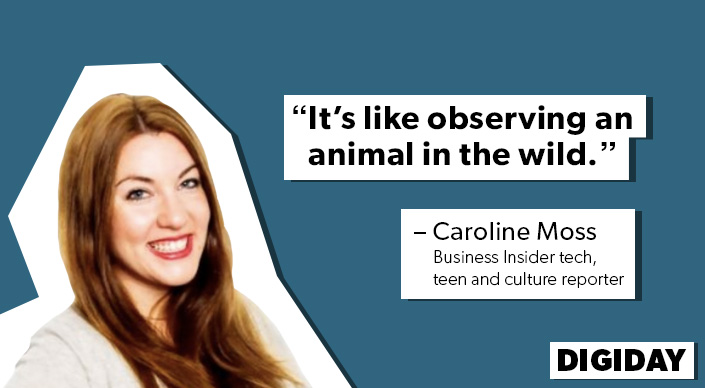Insights from CTV leaders at Dentsu, Horizon Media and more

It is the sacred right of every generation to poke fun at the teens in the cohort that follows. The current batch is no exception. With their top-heavy social media diet, more than a quarter of teens today (29 percent) report being more engaged with their online lives than their IRL activities.
While that stat, reported in the Cassandra Report’s Fall/Winter edition last year, may be worrying to some parents out there, media companies have taken note. Business Insider, for its part, has gone so far as to create a beat specifically to cover the millions of people who straddle the millennial-Gen Z divide. Meet BI’s teen beat reporter: Caroline Moss, 27, who joined Business Insider after a stint in the non-profit sector, and who proudly refers to herself as ‘Teen Correspondent’ in her Twitter bio.
“Caroline’s job is to cover Internet culture,” her editor Jay Yarow, told Digiday. “Everyone knows things are going digital. There’s a major generational shift away from traditional media like TV toward new services and categories, and we want to capture that shift.”
Digiday caught up with Moss to discuss her job and what makes teens such an insightful bunch to report on:
How were you assigned the “teen” beat?
I started off at Business Insider in August 2013, and I was originally hired to write about the intersection between technology and culture. So basically how people use technology we’re presented with. Slowly over time, that evolved into taking more of an interest in apps like Facebook, Instagram and Snapchat — things that are more teen-centric. So as a joke, they were like, ‘Oh, you’re the teen reporter.’ But I really am just a reporter. Anything that has to do with teenagers or the younger generation is usually in my coverage.
Why do teens interest you as a reporter?
I think it’s really interesting to look at the younger generation — how they use technology and how that’s going to affect them when they’re out in the real world, whether it’s getting jobs or starting their own companies. I think it’s really easy for people to want to dismiss teenagers – that it’s something that they’ll grow out of, or their behavior is something that should be ignored. But it’s important to observe how these kids are taking in all this technology and how they’re utilizing it.
Why?
We cater to a really professional audience, and when an app is valued at a high price, part of my job is to give the context: Why Whatsapp is worth billions of dollars, why Snapchat decided not to sell to Facebook. I cover the business angle, but I also cover the social angle.
What’s unique about the beat?
They’re just doing what comes naturally to them. It’s like observing an animal in the wild. They’re just socially and innately doing what they want to do. Looking at all this is very interesting.
Plus, brands are obsessed with them.
Yeah, millennials are huge targets for brands and corporations across the world — every brand wants to get into the millennial head and see how they work, and see how they tick and see what makes them buy something, or makes them watch something or makes them do something. What’s important is that it’s much more interesting to say that “Whatsapp just sold for billions of dollars, and this is what Whatsapp is and this is who’s using Whatsapp, and this is the kind of stuff that goes on on Whatsapp,” rather than just delivering the news of the valuation. And I think Business Insider and its readers really value that context.
And what’s the mandate you get from your editor?
Overall, I’m really encouraged to find out what the next big trend is, to find out what’s going to sell for $5 billion in three months, to figure out what these kids are using. You know, Snapchat really isn’t a story anymore; it’s in the news all the time. What I worry about are the apps that everyone in high school uses that everyone else hasn’t heard about yet. So the mandate really is go figure out what the next big thing is.
How do you keep on top of it all?
I read everything I can, talk to all the people who’ll talk to me, talk to the professionals. I talk to my 15-year-old cousin; I talk to my 18-year-old sister.
What are some of your favorite stories?
One of my favorite stories this year has been this onslaught of gossip apps that allow users to remain anonymous and how that’s affecting the culture at schools. We also did a really great story last May, when the Snapchat update came out. We spoke to this high school teacher about what happened when the update came out: Her class went out of control; all the kids stopped paying attention; all they did was stare at their phones. You can talk to any professional in any business, but those first-hand examples of the effects — that’s where all the interesting stories are. You can zoom into those small anecdotes and find research and facts to back them up.
More in Media

Digiday+ Research: Publishers pull back their dependence on digital revenue
After a year in which publishers shifted their revenue dependence away from traditional channels and toward digital channels, 2025 has seen a shift back toward more of a balance between traditional and digital revenue sources.

LinkedIn makes it easier for creators to track performance across platforms
Creator data is becoming more accessible to third-party vendors via a new API — another step in LinkedIn’s creator platform evolution.

Ad Tech Briefing: The ‘plumbers’ posing as the unlikely saviors of the internet
After several false dawns, can Cloudflare’s ‘anti-AI scraping tool’ finally offer publishers a road to commercial redemption?






